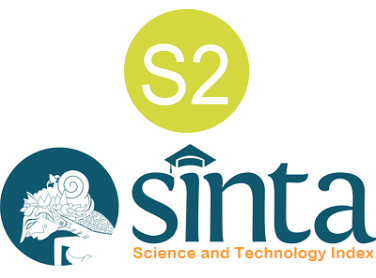Barong Bulu Goak Dalam Kajian Teo Estetika Hindu
DOI:
https://doi.org/10.37329/jpah.v9i1.3182Keywords:
Barong, Barong Bulu Goak, Theo-AestheticsAbstract
Barong Bulu Goak is a unique manifestation of culture and spirituality in Hindu society in Bali. Known for its rare and sacred presence, the Barong Bulu Goak attracts attention because it uses crow feather decoration, which is rarely used in other types of barong. This research aims to explore the theological and aesthetic depth surrounding Barong Bulu Goak in the context of Balinese culture. This research uses a descriptive qualitative approach to explore the symbolic role, ritual and theological meaning of Barong Bulu Goak in Balinese society. The main focus of this research is to explore the Theo-Aesthetic aspects surrounding Barong Bulu Goak, relate it to Hindu theological concepts, and explore how the use of crow feathers as an aesthetic element influences aesthetic perception and experience. In the context of theo-aesthetics, this research explains how Hindu theological concepts related to Brahman and its manifestations in everyday life are combined with aesthetic experiences through performing arts. The results of the research present that Barong Bulu Goak shows a tendency in its appearance and rituals to exude beauty or Ramya Tattwa and also the Suwung Tattwa phase which reflects aspects of Balinese artistic aesthetics. The concept of ramya refers to the integrated beauty of make-up, movement, and rituals that attract attention and radiate feelings of joy and satisfaction in religious ceremonies. Suwung presents quiet moments that provide opportunities for spiritual reflection and deep appreciation of the presence of Barong Bulu Goak in the ritual until the peak of the experience is known as saktibhava, marking the moment where the ceremony participants feel connected spiritually which indicates the existence of Barong Bulu Goak is a creative expression which shows how spiritual and aesthetic life in the Hindu context can combine in a deep experience, giving rise to the power of spirituality in the perception of beauty.
References
Adhikary, N. M. (2009). An Introduction to Sadharanikaran Model of Communication. Bodhi: An Interdisciplinary Journal, 3(1), 69-91.
Avalon's, A. (1973). Tantra of The Great Liberation. Denpasar: Upada Sastra.
Avalon's, A. (2015). The Serpent Power the Secrets of Tantric and Shactic Yoga. New York: Dover Publications.
Bandem, I. M. (2013). Gamelan Bali di Atas Panggung Sejarah. Denpasar: STIKOM Bali.
Bandem, I. M., Rota, K., & Bagiartha, I. W. (1989), Transformasi Sastra Calonarang di Dalam Seni Calonarang di Bali Denpasar: ISI.
Dibia, I. W. (2003). Estetika Dalam Pembangunan Bali. Denpasar: Program Magister Ilmu Agama dan Kebudayaan UNHI.
Dibia, I. W. (2012). Taksu Dalam Seni dan Kehidupan Bali. Denpasar Bali Mangsi Foundation.
Djelantik, M. (1999). Estetika Sebuah Pengantar. Jakarta: Masyarakat Seni Pertunjukan Indonesia
Kardji, I. W. (1993). Mistisisme dan Barong Bali dalam buku Kiwa - Tengen dalam Budaya Bali (Editor: Jiwa Atmaja). Denpasar: CV Kayumas.
Nazir, M. (1985). Metode Penelitian. Jakarta: Ghalia Indonesia
Robson, S. O. (1983). Kakawin Reconsidered: Toward A Theory of Old Javanese Poetics. Bijdragen Tot De Taal, Land-En Volkenkunde, 291-319.
Strauss, A., & Corbin, J. (2003). Dasar-dasar Penelitian Kualitatif: Tata langkah dan Teknikteknik Teoritisasi Data. Yogyakarta: Pustaka Pelajar.
Suamba, I. B. P. (2010). Pengantar Filsafat India. Denpasar: UNHI Denpasar.
Subagia, I. M. (2014). Ritual Tantrik Ngerehang Barong dan Rangda di Desa Pakraman Kerobokan, Kecamatan Kuta Utara Kabupaten Badung. Denpasar: Program Doktor Program Studi lImu Agama Pasca Srajana, IHDN Denpasar.
Sukayasa, I. W. (2007). Teori Rasa Memahami Taksu, Ekspresi dan Metodenya. Denpasar: Program Magister Ilmu Agama dan Kebudayaan UNHI
Sudiana, I. G. N. (2006). Desakralisasi Tari Barong dalam Kehidupan Sosial Budaya Masyarakat Bali. Jurnal Akademika, 4(1).
Wicaksana, I. D. K. (2018). Konsep Teo-Estetika Teks Dharma Pawayangan Pada Pertunjukan Wayang Kulit Bali. Segara Widya: Jurnal Hasil Penelitian dan Pengabdian Masyarakat, 6(1).
Wirawan, K. I. (2015). Keberadaan Barong dan Rangda Dalam Dinamika Religius Masyarakat Bali. Surabaya: Paramita.
Wirawan, K. I. (2016). Keberadaan Barong & Rangda Dalam Dinamika Religius Masyarakat Hindu Bali. Surabaya: Paramita.
Zoetmulder, P. J. (1983). Kalangwan: Sastra Jawa Kuno, Selayang Pandang. Jakarta: UI Press.
Downloads
Published
How to Cite
Issue
Section
License
Copyright (c) 2025 I Gusti Ngurah Pertu Agung

This work is licensed under a Creative Commons Attribution-ShareAlike 4.0 International License.
An author who publishes in the Jurnal Penelitian Agama Hindu agrees to the following terms:
- Author retains the copyright and grants the journal the right of first publication of the work simultaneously licensed under the Creative Commons Attribution-ShareAlike 4.0 License that allows others to share the work with an acknowledgement of the work's authorship and initial publication in this journal
- Author is able to enter into separate, additional contractual arrangements for the non-exclusive distribution of the journal's published version of the work (e.g., post it to an institutional repository or publish it in a book) with the acknowledgement of its initial publication in this journal.
- Author is permitted and encouraged to post his/her work online (e.g., in institutional repositories or on their website) prior to and during the submission process, as it can lead to productive exchanges, as well as earlier and greater citation of the published work (See The Effect of Open Access).
Read more about the Creative Commons Attribution-ShareAlike 4.0 Licence here: https://creativecommons.org/licenses/by-sa/4.0/.








